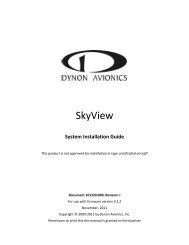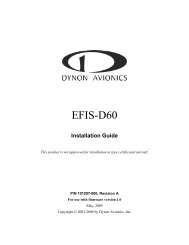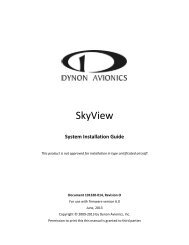EFIS-D100 Installation Guide - Dynon Avionics
EFIS-D100 Installation Guide - Dynon Avionics
EFIS-D100 Installation Guide - Dynon Avionics
You also want an ePaper? Increase the reach of your titles
YUMPU automatically turns print PDFs into web optimized ePapers that Google loves.
Appendix<br />
Markers Configuration<br />
The HS34 supports markers input via ARINC or the 3 discrete Inner, Middle, and Outer marker<br />
pins.<br />
If your NAV radio outputs ARINC data whose stream contains marker information, set the<br />
SOURCE to either ARINC1 or ARINC2. ARINC1 corresponds to the ARINC-429 RX 1 A and<br />
B inputs (female DB25, pins 11 and 23). ARINC2 corresponds to the ARINC-429 RX 2 A and B<br />
inputs (female DB25, pins 10 and 22). You must also ensure that the corresponding INPUT1 or<br />
INPUT2 parameter in the ARINC-429 menu is set to GAMA NAV.<br />
If you have a device which outputs marker data via 3 discrete signals, set the SOURCE to<br />
MRKR PINS. Ensure that your device’s Outer, Middle, and Inner outputs are connected to the<br />
HS34’s male DB25 pins 22, 23, and 24, respectively. Marker beacon receivers use a variety of<br />
techniques to output the 3 marker signals. Because of this, you may need to experiment with the<br />
PULL-UP and ACTIVE WHEN parameters. As a general rule of thumb, if the schematic for<br />
your receiver shows the 3 discrete outputs connected to lights whose other side is connected to<br />
power, set PULL-UP to Y and ACTIVE WHEN to LOW. Likewise, if the schematic shows the 3<br />
discrete outputs connected to lights whose other side is connected to ground, set PULL-UP to N<br />
and ACTIVE WHEN to HIGH.<br />
Regardless the input type used, you can configure the HS34 to output tones for Outer (Morse<br />
code “dashes”), Middle (Morse code “dot-dashes”), and Inner (Morse code “dots”) markers. Set<br />
TONES ACTIVE to Y to configure the HS34 to output the tones for each of the 3 markers. Set it<br />
to N to configure the HS34 to have no audible marker feedback.<br />
DME Configuration<br />
The HS34 supports Distance Measuring Equipment receiver input via ARINC or the single DME<br />
Analog In pin (female DB25, pin 6).<br />
If you have connected a DME receiver which outputs ARINC data, set the SOURCE to either<br />
ARINC1 or ARINC2. ARINC1 corresponds to the ARINC-429 RX 1 A and B inputs (female<br />
DB25, pins 11 and 23). ARINC2 corresponds to the ARINC-429 RX 2 A and B inputs (female<br />
DB25, pins 10 and 22). You must also ensure that the corresponding INPUT1 or INPUT2<br />
parameter in the ARINC-429 menu is set to DME.<br />
If you have connected a DME receiver to the HS34’s DME Analog In pin, set the SOURCE to<br />
DME PIN.<br />
GPS and NAV Display Order Configuration<br />
Pressing the NAV SRC button on the HS34 cycles through the available NAV sources in the<br />
following order: DG, NAV1, NAV2, etc., GPS1, GPS2, etc. Of course, the numbers of NAVs<br />
and GPSs in the cycle depend on how many of each type are configured in the ANALOG,<br />
SERIAL, and ARINC-429 menus.<br />
If you have configured more than one input to receive NAV radio data, enter the NAV ORDER<br />
menu to see the list of configured NAV radios and the HS34 inputs they are connected to. In this<br />
menu, you may change the order that each NAV input occurs within the NAV portion of cycle. If<br />
you do not see all expected NAV radios, verify that all settings are accurate in the ANALOG,<br />
SERIAL, and ARINC-429 menus. Press DOWN▼ or UP▲ to select the input that you wish to<br />
7-20 <strong>EFIS</strong>-<strong>D100</strong> <strong>Installation</strong> <strong>Guide</strong>
















